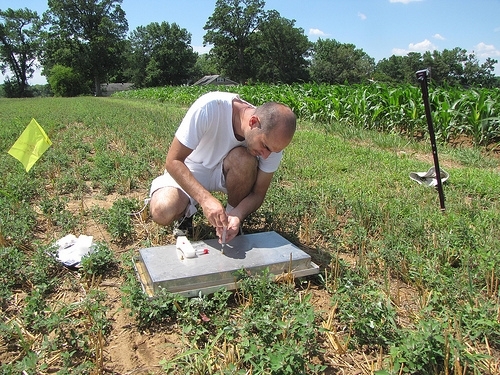ARS Labs Unravel Genetics of Greenhouse Gas Emissions

SASL team member graduate student Milutin Djurickovic samples greenhouse gases in the long-term Farming Systems Project. (Photo credit Michel Cavigelli)
This post is part of the Science Tuesday feature series on the USDA blog. Check back each week as we showcase stories and news from USDA’s rich science and research portfolio.
Understanding the causes of greenhouse gas (GHG) emissions from agricultural landscapes is truly a multi-scale challenge, with GHG sources ranging from whole plant, to the microscopic microbe level. For example, denitrification, the production of nitrous oxide, is the result of the action of just a few unique enzymes produced by a small number of bacteria and fungi in the soil. These small players have huge importance because nitrous oxide is a greenhouse gas 300 times more powerful than carbon dioxide. Increases in nitrous oxide and other GHGs have been implicated in major global changes such as increased mean annual temperatures, resulting in melting glaciers, increasing floods, and more frequent heat waves.
At the USDA Sustainable Agriculture Systems Laboratory (SASL), Scientist Michel Cavigelli and I are working to understand these small players by unraveling the drivers of greenhouse gas emissions from no-till, conventional till and organic agricultural systems. We are conducting experiments that seek to understand how these different management approaches for the production of corn, soybean and wheat impact the genetic regulation of soil microbes responsible for the production of nitrous oxide. As part of the long-term Farming Systems Project (FSP) at the Beltsville Agricultural Research Center, we have found that crop species, time of year, and type of management system (conventional or organic) all have significant effects on the quantity and diversity of the microbial genes responsible for the process of denitrification. The FSP experiment has been going on for 16 years, and over that time the structure and composition of the microbial community capable of producing nitrous oxide has diverged between the conventional and organically managed small grain production systems. We are now conducting experiments to determine the most important factors causing differences in the microbial communities, and identifying what land managers can do to reduce GHG emissions through appropriate management decisions. In related research, the SASL team has found that soil microbial processing of nitrogen tends to be more resistant to disturbance in farming systems that use long crop rotations and have high plant species diversity. What these results mean is that field-level management decisions regarding crop rotation length and crop species selection don’t just impact the plants you grow, but can also have longer-term impact at the molecular scale.
Work from SASL is helping USDA understand the processes that underlie greenhouse gas emissions, and ultimately that lead to major global climactic changes. This work, along with that of many other ARS labs, is preparing America’s farmers for coming environmental change, and plays a major role in making US agriculture strong and resilient now and into the future.
Donate to Motion Center:

No comments:
Post a Comment